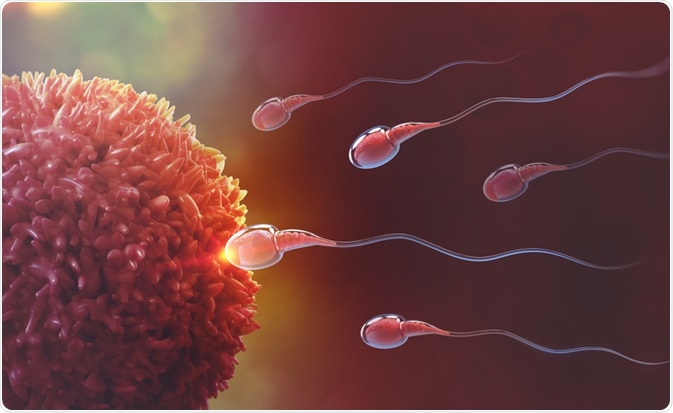Female fertility and the factors that regulate fertility are multifactorial. Genetics for common traits associated with reproductive lifespan and common diseases influencing female fertility are significant factors and show substantial variation.

Image Credit: Yurchanka Siarhei/Shutterstock.com
In the last decade, genome-wide association studies (GWAS) have shaped understanding of the genetic contributions to complex reproductive traits such as the onset of puberty, age-specific fertility rates, and twinning frequency, as well as diseases and conditions such as polycystic ovarian syndrome (PCOS) and endometriosis.
Genetics of reproductive lifespan
Reproductive lifespan is defined as the time from the onset of puberty until menopause. At menopause, the number of available oocytes is depleted and the menstrual cycles cease.
During gestation, primordial follicles develop, resulting in a final oocyte pool at birth, which subsequently declines to the point of menopause associated with declining fertility and increased twinning rates with age.
There is wide variation in the timings of the events, as well as the age of menarche (first menstrual cycle) and menopause. This has consequent impacts on fertility, hypertension, cardiovascular disorders, glucose intolerance, osteoporosis, obesity, breast, ovarian, and endometrial cancers.
The genetics of menarche
The timing of puberty is a genetically determined trait that can affect fertility. Certain mutations have been identified that disrupt the development in the function of hormones implicated in the maturation of oocytes, which can result in a condition known as idiopathic hypogonadotropic hypogonadism (IHH). This can result in the absence of puberty.
These include mutations in genes for kisspeptin (KISS1), GnRH (GNRH1), follicle-stimulating hormone (FSH), luteinizing hormone (LH), and their respective receptors.
Conversely, central precocious puberty (CPP), a condition in which puberty starts at a very early age is also controlled by activating mutations in KISS1 and kisspeptin receptor (KISS1R), as well as inherited mutations in two genes Makorin ring-finger 3 (MKRN3) and Delta-like 1 homolog (DLK1).
MKRN3 is expressed from the paternal allele and inhibits the secretion of GnRH during the prepubertal period in childhood. Overall, loss-of-function alleles in these two paternally expressed genes support the effect of imprinting on the timing of puberty.
Moreover, GWAS studies have revealed positive enrichment for age at menarche-associated variants in five central nervous system tissues, supporting an important role of these systems in reactivation of the hypothalamic-pituitary axis and onset of puberty.
Genetics of fertility and reproductive behavior
Fertility traits in populations have a genetic basis of control. Successful reproduction denoted by age at first birth (AFB) and the associated behavior of age at first sexual intercourse (AFS) are considered to be moderately heritable traits and are genetically correlated.
GWAS studies have identified 34 significant signals which include association with single nucleotide polymorphism (SNP) in the estrogen receptor 1 gene that is also associated with AFB.
SNP is a DNA sequence variation occurring when a single nucleotide differs between members of a species or paired chromosomes in an individual.
On chromosome 3 a single nucleotide polymorphism with AFS is highly correlated with a missense variant in the semaphorin protein SEMA3F. This also influences the expression of RNA binding protein RMB6. Moreover, the AFB allele is associated with later menarche and earlier age at first birth, with greater births.
10 independent genomic loci associated with AFB in women have been identified from a large study of genetic effects on reproductive behavior in cohorts of women with European ancestry. these studies identified several genes associated with AFB.
The critical SNPs on chromosome 1 associated with AFB and the number of children born are thought to be correlated with nonsynonymous SNPs in two genes; the CREB-regulated transcription co-activator 2 (CRTC2) and CREB protein 3 like 4 (CREB3L4). CRTC2 acts downstream of FSH in ovarian granulosa cells.
The complexity of genetics and fertility
GWAS studies have revealed shared biological pathways linking puberty timing, fertility, reproductive aging, and health outcome.
Many variants influencing menopause implicate genes involved in DNA damage/repair with implications for follicle health and aging. However, it is important to note that the responsible mechanisms remain to be elucidated.
The size of the effects for common variants in genes implicated in fertility are small, and this is important for large studies to identify a fraction of variance which underlie variation for traits and diseases related to fertility periods moreover, identify regions in the genome, but not the specific genes and pathways that regulate variation in fertility. As a result, there are large gaps in evidence for causal variants, although potential candidate genes have been pinpointed.
Functional evidence remains to be produced to identify target genes and mechanisms responsible, providing a greater understanding of specific pathways that regulate aspects of reproductive life span and fertility.
Sources:
- Kim Y, Lee JJ. The genetics of human fertility (2019) Curr Opin Psychol. doi: 10.1016/j.copsyc.2018.07.011.
- Gajbhiye R, Fung JN, Montgomery GW. (2020) Complex genetics of female fertility. npj Genomic Med. Doi:10.1038/s41525-018-0068-1.
Further Reading
Last Updated: Dec 14, 2021